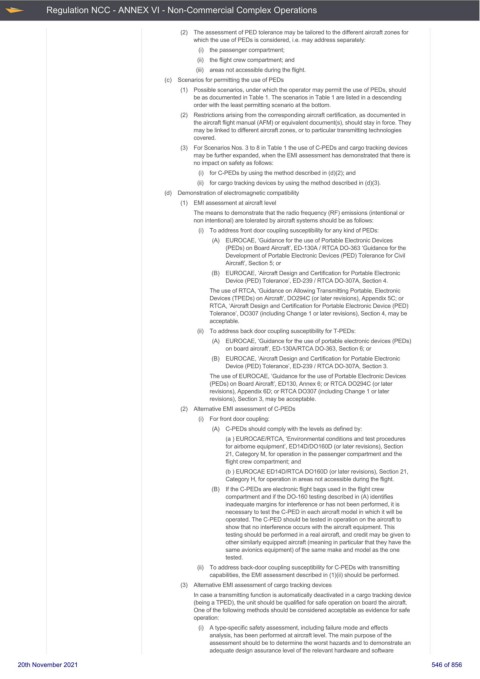Page 546 - UK Air Operations Regulations 201121
P. 546
~
~ Regulation NCC - ANNEX VI - Non-Commercial Complex Operations Centrik
(2) The assessment of PED tolerance may be tailored to the different aircraft zones for
which the use of PEDs is considered, i.e. may address separately:
(i) the passenger compartment;
(ii) the flight crew compartment; and
(iii) areas not accessible during the flight.
(c) Scenarios for permitting the use of PEDs
(1) Possible scenarios, under which the operator may permit the use of PEDs, should
be as documented in Table 1. The scenarios in Table 1 are listed in a descending
order with the least permitting scenario at the bottom.
(2) Restrictions arising from the corresponding aircraft certification, as documented in
the aircraft flight manual (AFM) or equivalent document(s), should stay in force. They
may be linked to different aircraft zones, or to particular transmitting technologies
covered.
(3) For Scenarios Nos. 3 to 8 in Table 1 the use of C-PEDs and cargo tracking devices
may be further expanded, when the EMI assessment has demonstrated that there is
no impact on safety as follows:
(i) for C-PEDs by using the method described in (d)(2); and
(ii) for cargo tracking devices by using the method described in (d)(3).
(d) Demonstration of electromagnetic compatibility
(1) EMI assessment at aircraft level
The means to demonstrate that the radio frequency (RF) emissions (intentional or
non intentional) are tolerated by aircraft systems should be as follows:
(i) To address front door coupling susceptibility for any kind of PEDs:
(A) EUROCAE, ‘Guidance for the use of Portable Electronic Devices
(PEDs) on Board Aircraft’, ED-130A / RTCA DO-363 ‘Guidance for the
Development of Portable Electronic Devices (PED) Tolerance for Civil
Aircraft’, Section 5; or
(B) EUROCAE, ‘Aircraft Design and Certification for Portable Electronic
Device (PED) Tolerance’, ED-239 / RTCA DO-307A, Section 4.
The use of RTCA, ‘Guidance on Allowing Transmitting Portable, Electronic
Devices (TPEDs) on Aircraft’, DO294C (or later revisions), Appendix 5C; or
RTCA, ‘Aircraft Design and Certification for Portable Electronic Device (PED)
Tolerance’, DO307 (including Change 1 or later revisions), Section 4, may be
acceptable.
(ii) To address back door coupling susceptibility for T-PEDs:
(A) EUROCAE, ‘Guidance for the use of portable electronic devices (PEDs)
on board aircraft’, ED-130A/RTCA DO-363, Section 6; or
(B) EUROCAE, ‘Aircraft Design and Certification for Portable Electronic
Device (PED) Tolerance’, ED-239 / RTCA DO-307A, Section 3.
The use of EUROCAE, ‘Guidance for the use of Portable Electronic Devices
(PEDs) on Board Aircraft’, ED130, Annex 6; or RTCA DO294C (or later
revisions), Appendix 6D; or RTCA DO307 (including Change 1 or later
revisions), Section 3, may be acceptable.
(2) Alternative EMI assessment of C-PEDs
(i) For front door coupling:
(A) C-PEDs should comply with the levels as defined by:
(a ) EUROCAE/RTCA, ‘Environmental conditions and test procedures
for airborne equipment’, ED14D/DO160D (or later revisions), Section
21, Category M, for operation in the passenger compartment and the
flight crew compartment; and
(b ) EUROCAE ED14D/RTCA DO160D (or later revisions), Section 21,
Category H, for operation in areas not accessible during the flight.
(B) If the C-PEDs are electronic flight bags used in the flight crew
compartment and if the DO-160 testing described in (A) identifies
inadequate margins for interference or has not been performed, it is
necessary to test the C-PED in each aircraft model in which it will be
operated. The C-PED should be tested in operation on the aircraft to
show that no interference occurs with the aircraft equipment. This
testing should be performed in a real aircraft, and credit may be given to
other similarly equipped aircraft (meaning in particular that they have the
same avionics equipment) of the same make and model as the one
tested.
(ii) To address back-door coupling susceptibility for C-PEDs with transmitting
capabilities, the EMI assessment described in (1)(ii) should be performed.
(3) Alternative EMI assessment of cargo tracking devices
In case a transmitting function is automatically deactivated in a cargo tracking device
(being a TPED), the unit should be qualified for safe operation on board the aircraft.
One of the following methods should be considered acceptable as evidence for safe
operation:
(i) A type-specific safety assessment, including failure mode and effects
analysis, has been performed at aircraft level. The main purpose of the
assessment should be to determine the worst hazards and to demonstrate an
adequate design assurance level of the relevant hardware and software
20th November 2021 546 of 856

